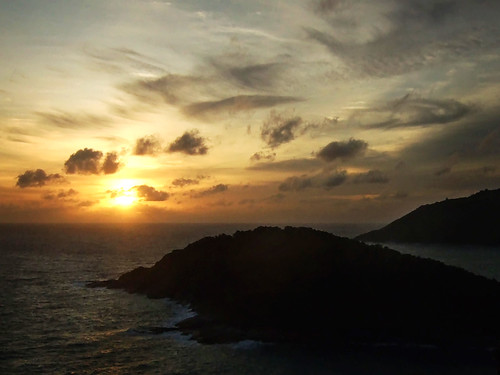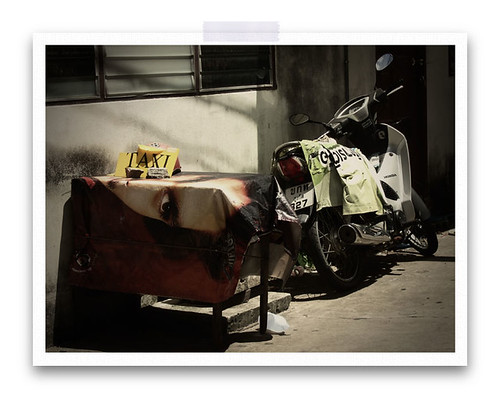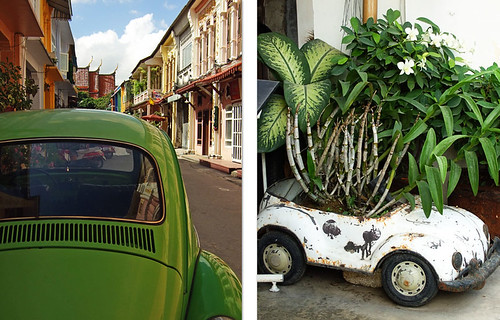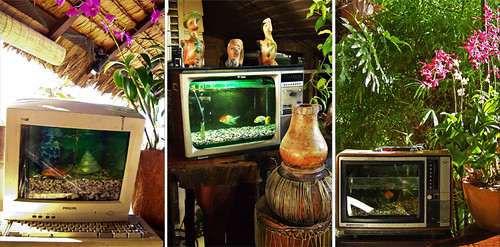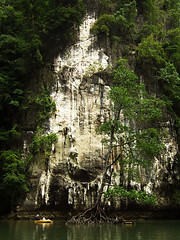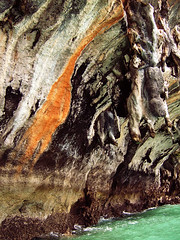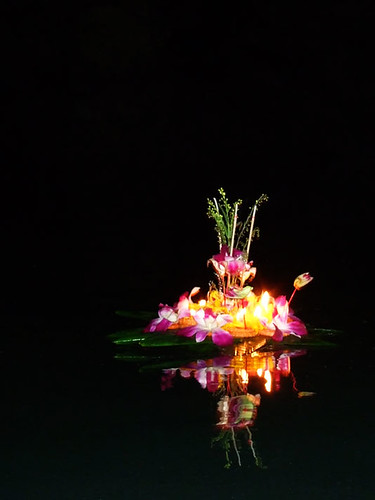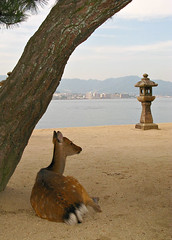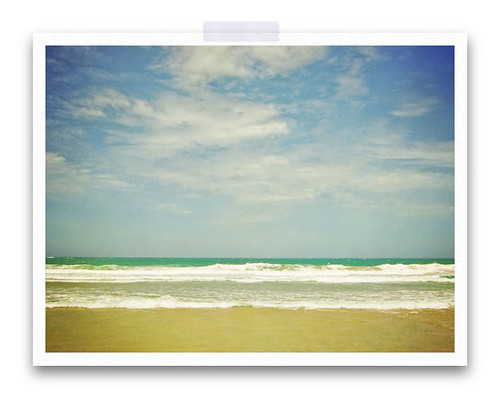
While our experience of Phuket was generally very positive, perhaps due to visiting in very low season, one of its annoyances was still in full swing: the powerful transport cartel that rules Phuket’s Western shores, resists all attempts to improve the abysmal state of public transport in Phuket and charges an arm and a leg to take you anywhere. I’m aware true travelistas would throw caution to the wind and vroom glamorously around the island on a rented moped, but ever since I heard what a state coroner had to say about motorbike travel I’ve been nervous about it. So the next best alternative was to engage a driver, and after a bit of research we contacted Daj, who is very popular with Tripadvisor forum members.
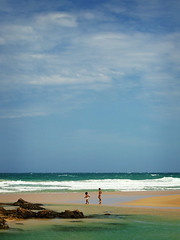 He picked us up at 10 a.m., and we headed south, passing Karon viewpoint on the way to the gorgeousness at the top of this post, Nai Harn beach. I don’t know what it’s like in high season, but on this low season Sunday morning it was pretty idyllic.
He picked us up at 10 a.m., and we headed south, passing Karon viewpoint on the way to the gorgeousness at the top of this post, Nai Harn beach. I don’t know what it’s like in high season, but on this low season Sunday morning it was pretty idyllic.
It’s popular with families because of its little lagoon that stays calm even as monsoon season waves crash onto the main stretch of beach. (I experimented with adding a texture when processing the photo below. I like the end result, but would be interested in your opinions: evocative or naff?)

 This family parked right next to the sand and picnicked while their kids played in the shallows.
This family parked right next to the sand and picnicked while their kids played in the shallows.
Once I’d managed to tear myself away from photographing Nai Harn beach, we drove on to Ya Noi viewpoint, which doesn’t photograph too badly itself.
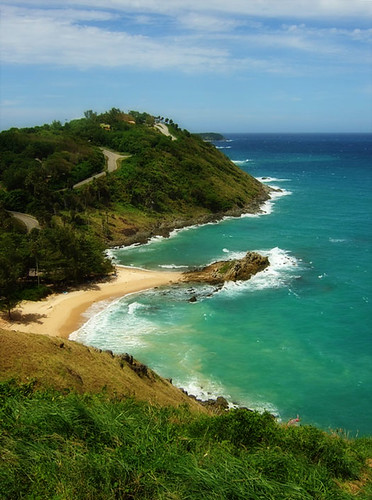
 At Rawai fishing village, I nearly fell prey to a very persuasive hard-sell. I bet she’d have overcharged me too.
At Rawai fishing village, I nearly fell prey to a very persuasive hard-sell. I bet she’d have overcharged me too.
The tsunami caused less destruction to Rawai than the west coast of the island, but I still found the sight of the children playing in front of the tsunami hazard zone sign poignant. I was delighted when I realized they were not only playing zero-point[1. I did a quick Google to see if I could rustle up a description of zero-point for non-Asian readers and found this bizarre video, apparently produced as some sort of outreach effort for the Youth Olympic Games Singapore’s hosting next year. The “fun” URL they’ve come up with for more of this stuff is “whyohgee.com.sg”. I think “doubleu-tee-eff.com.sg” might have been more appropriate.] – one of my favourite childhood games that I’d somehow forgotten ever playing until seeing them – but playing some of the exact same “stages” of the game that we did twenty years ago.

While waiting to work up an appetite for lunch, we went to see the Big Buddha, already seen in distant evening silhouette in the previous post, and really damn freaking big when you’re up close. The statue is still under construction and surrounded by scaffolding, which makes for easy cheesy faux-spiritual photo captioning as follows. (I tried another texture experiment with the photo – again, opinions appreciated!)

 Wat Chalong doesn’t have the history or ornate decoration of other temples you can see in Thailand, but it does feel like it has a life as a local centre of worship beyond its tourist visitors, which is what I always hope to see in religious sites I visit.
Wat Chalong doesn’t have the history or ornate decoration of other temples you can see in Thailand, but it does feel like it has a life as a local centre of worship beyond its tourist visitors, which is what I always hope to see in religious sites I visit.

For lunch, Daj drove us to Phong Phang Seafood at Palai bay. Upon walking in it was immediately obvious that this was the sort of place where all the guides take their tourists – it even had a separate room where all the guides were eating their own lunches – but the food turned out very decent. The “apple balsam leaves salad” (sounded interesting, but I still have no idea if that’s the correct name of the leaf or not) in the photo was the first dish we’d had in Phuket where we found the level of spice remotely challenging, so given our reasonably high tolerance for spice I’d say the restaurant hasn’t totally watered its food down for tourists. The ambience is pleasant too, sitting in breezy shade looking out at long-tail boats in the bay. I scampered a few metres down to the beach after lunch for this picture, which I quite like.

 After lunch we went to Khao Kad viewpoint at Cape Panwa (my photographs weren’t very good) and the monkey mangroves at Ko Sireh. It was rather depressing that visitors are not in the least bit discouraged from feeding the monkeys here (we didn’t), so I expect some of the monkeys just spend a lot of their day lounging by the river eating fruit that literally landed right at their feet.
After lunch we went to Khao Kad viewpoint at Cape Panwa (my photographs weren’t very good) and the monkey mangroves at Ko Sireh. It was rather depressing that visitors are not in the least bit discouraged from feeding the monkeys here (we didn’t), so I expect some of the monkeys just spend a lot of their day lounging by the river eating fruit that literally landed right at their feet.
In accordance with my strange tendency to be besotted with every kind of animal baby except the human baby, I squealed a bit at this.

In conversation during the drive, Alec asked if Daj knew a good place to buy muay thai shin pads and most conveniently, it turned out that Daj has been doing muay thai since he was a child. He said that for good quality shin pads we could go to Jungceylon (snazzy tourist mall at Patong) but for cheaper stuff there was a place in Phuket Town that locals would usually go. I expressed the view that we should buy shin pads at a value commensurate with the quality of Alec’s muay thai skills, so we went to Phuket Town.
The place the locals shop is called Supercheap, and is pretty fantastic. It’s in a dim, cavernous warehouse space bigger than any hypermart in Singapore, with an incredible range of choices for anything you could dream of buying. It’s difficult to capture in pictures and I didn’t wander too far from Alec and Daj while they were poring over the shin pads for fear of getting lost, but I saw electric guitars in the distance, multiple three-tiered shelves of children’s tricycles and more varieties of rice than I have ever seen in one place.
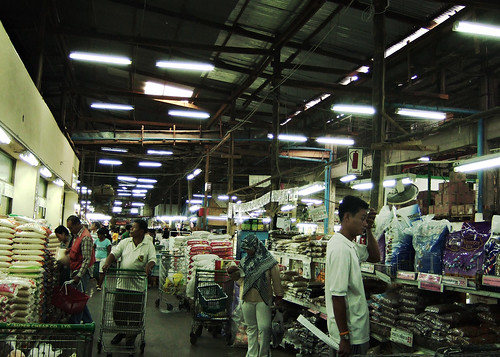


Once the boys were done with their shopping (Alec got his shin pads, Daj got craft scissors for his daughter), Daj drove us to his friend’s muay thai gym to let Alec have a look at it, but unfortunately they don’t train on Sundays so nothing was going on when we got there. The last stop before dinner was the obligatory sunset at Laem Phromthep, and Daj had got his wife and daughter to meet him there. We didn’t find the crowds detracted from the experience, though perhaps it’s different in high season, but as scenery goes I was a little underwhelmed. Sunsets are always beautiful, but this spot probably isn’t so significantly more beautiful than other sunset views in Phuket as to justify the hassle of finding a parking lot.
We ended the day in Rawai again for dinner, with fish grilled in salt, fried chicken with garlic and pepper, clear sour seafood soup, steamed rice and 2 Cokes for under 500 baht. The chicken was a disappointment (soggy) but the seafood dishes were unsurprisingly fresh and generously portioned. They initially brought us an insipid sweet’n’sour sauce with the fish so we asked for something spicier and got the proper Thai stuff. I always blame stuff like this on the white dude who goes around with me.
Finally back at the hotel, we bid farewell to Daj. For anyone who comes across this post while researching a trip to Phuket, we found him professional, cheerful and responsive to our particular requests, such as going to Supercheap for the muay thai gear, and his English is fairly good. I’m sure that finding our own way around Phuket on rented transport would have been lots of fun in a different way, but we were happy with our day with him.
